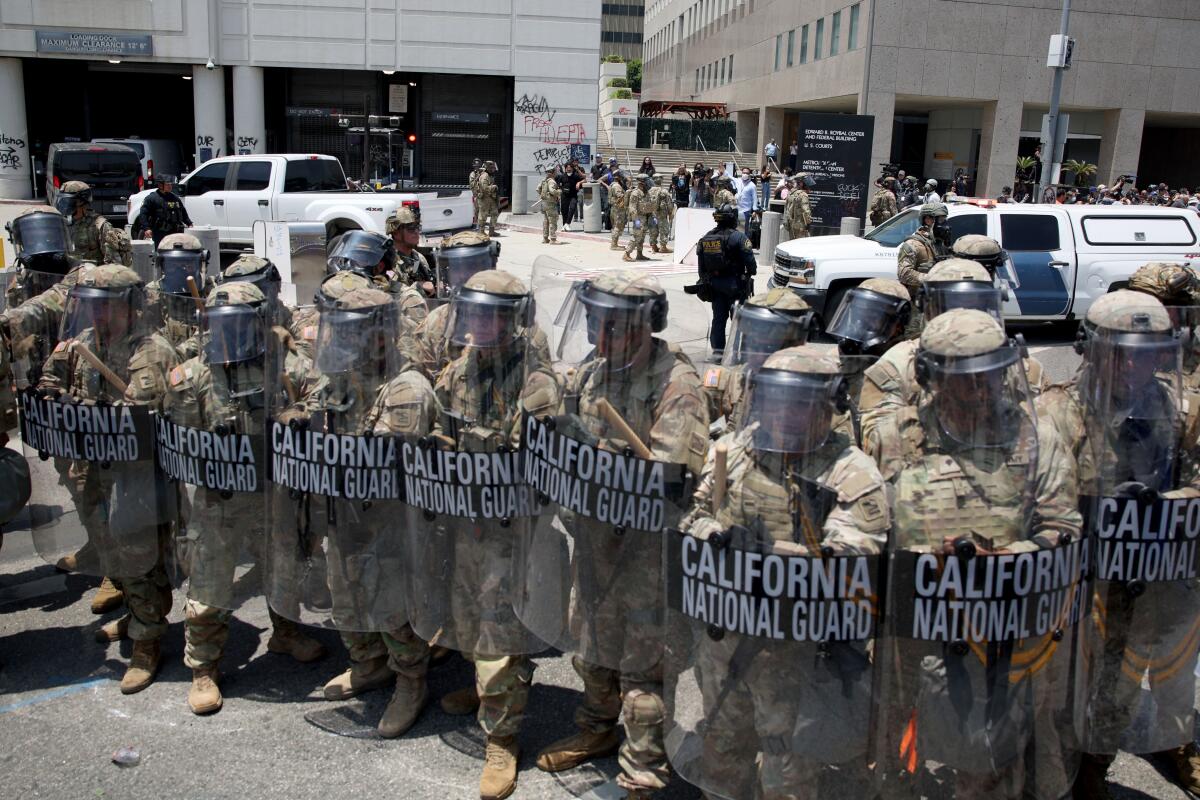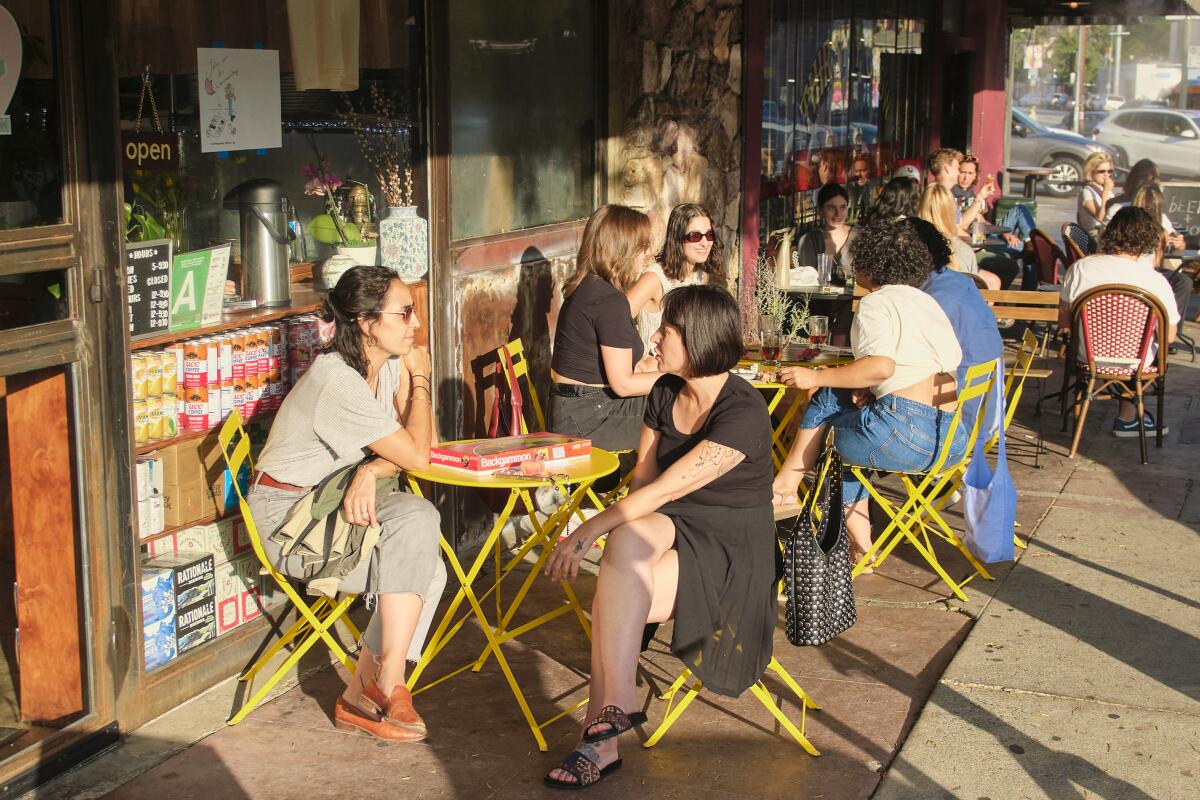Newsom vs. Trump: What to know about California’s lawsuit against the federal government

- Share via
Even a casual reader of this newsletter knows the Trump administration has deployed nearly 7,000 federal troops to L.A. over the last two weeks. Most also know California officials sued to stop them.
(I reported earlier that the line he shall take Care that the Laws be faithfully executed from Article II, Section 3 of the Constitution was first invoked to deploy troops against civilians to enforce the Fugitive Slave Act.)
You're reading the Essential California newsletter
The most important California stories and recommendations in your inbox every morning.
You may occasionally receive promotional content from the Los Angeles Times.
But if your life and your For You Page are anything like mine, you may not have kept up with the details since then. So as your resident legal affairs correspondent, I’m here to tell you what’s happening with California’s lawsuit against the federal government, and what you should watch for next.
Newsom vs. Trump in a nutshell
California’s June 9 suit makes two big legal claims:
- that the unrest in L.A. was insufficient to justify the powers Trump invoked to quell it
- that federalized troops were doing (or were likely to do) things they’re not allowed to in those circumstances.
On June 12, U.S. District Judge Charles R. Breyer — the bowtie-wearing brother of retired U.S. Supreme Court Justice Stephen Breyer — agreed with the first set of claims, saying the government hadn’t shown evidence of a “rebellion” in Los Angeles and that civilian efforts to frustrate ICE raids were not disruptive enough to trigger 10 U.S.C. § 12406. He issued an order that would have given control of most troops back to Gov. Gavin Newsom.
Trump appealed the order. The 9th Circuit hit pause to review it, leaving the troops in Trump’s hands. A week later, the appellate panel tossed out Breyer’s order entirely. In the court’s Juneteenth ruling, Judge Mark J. Bennett wrote that the Constitution and the U.S. Code gave the president broad authority to interpret the facts as he saw them.
But neither court has yet opined on California’s second major claim: that by assisting immigration raids, troops under Trump’s command violated the Posse Comitatus Act of 1878, which forbids soldiers from enforcing civilian laws.
(That law has an “ignominious” history. I’ll explain more later this week.)
On Tuesday, Breyer gave state attorneys the green light to start collecting evidence about troop activities “on the streets of communities in Southern California”, and to depose key officials, including ICE Enforcement and Removal Operations Field Office Director Ernesto Santacruz Jr. and Maj. Gen. Niave F. Knell.
Meanwhile, DOJ lawyers argued troops aren’t enforcing civilian law; and even if they were, that would be allowed under the statute; and even if it wasn’t, the Northern District of California has limited authority to say so.
(Anyone who listened to Assistant Atty. Gen. Brett Shumate argue before the 9th Circuit last week will instantly recognize this as his signature style.)
So what happens now?
Trump’s June 7 executive order called up troops for 60 days — or at the discretion of the secretary of Defense. Does that mean soldiers could be deployed in Los Angeles indefinitely? That’s something California lawyers have sought to clarify through the courts while the PCA claim is heard. In his Tuesday order, Breyer signaled he could weigh in on it. The one thing we can say for sure is, if California wins, the Trump administration will appeal.
Today’s top stories

Gender identity in sex education lessons
- California has 60 days to remove gender-identity materials from sex education curriculum or risk losing losing more than $12.3 million in federal grants.
- The order is the latest clash between the administration and California related to LGBTQ+ issues.
- Amid growing political pressure from the Trump administration, Stanford Medicine has ended surgeries for transgender minors.
Immigration raids
- Increasingly aggressive immigration raids carried out by masked federal agents, sometimes using unmarked vehicles, are creating problems for local law enforcement agencies.
- The recent immigration sweeps have underscored how much of an issue skin color — and all the circumstances that attach to it — is for Latinos.
- Data suggest a majority of those who have been arrested in L.A. raids were not convicted criminals. Most were working-age men, nearly half Mexican.
Israel-Iran ceasefire
- A classified report casts doubt on President Trump’s assertions that Iran’s nuclear facilities were “completely and totally obliterated.”
- Israel’s tally of the war damage it wrought on Iran includes the targeted killings of at least 14 scientists.
- Trump, basking in Mideast ceasefire, displays a flare of frustration with Putin.
- A look at Al Udeid Air Base, the U.S. military site that Iran attacked.
- How Trump’s attack on Iran pushed diplomacy with Kim Jong Un further out of reach.
What else is going on
- Newsom and the Democrats announce $321-billion California budget deal.
- A man dives off a California waterfall, two others try to save him; all three drown.
- Seven California faults that could produce among the most devastating earthquakes.
- L.A. high school football star and San José standout Chandler Jones has died at 33 in a freeway accident.
- Bobby Sherman, ’60s teen idol from music and TV, has died at 81.
- A fitness influencer mother was killed by her estranged husband while out on a date.
- One of the oldest movie studios in Los Angeles is up for sale, even as filming dips.
- Kroger, the company behind Ralphs and Food 4 Less, plans to close 60 locations.
Commentary and opinions
- Columnist Anita Chabria writes about how conflict with Iran could supercharge Trump’s domestic agenda.
- You can’t separate sports from politics. Just ask the L.A. Dodgers, writes columnist Mark Z. Barabak.
- What is the state of Latin music today? A panel of Latin America’s boldest and brightest stars weigh in on a rapidly globalizing genre.
- The Trump administration threatened to punish Children’s Hospital Los Angeles if it continued to serve trans kids. That’s no way to decide what medical services patients will receive, argues guest columnist Gabriel Kahn.
This morning’s must-reads
A new data tool shows how large the gaps are between environmental health risks and outcomes in Latino and white neighborhoods in Los Angeles.
Other must-reads
- How to get along when college grads move back home with parents.
- The Hollywood sign and … Erewhon? How the luxury grocery store became an L.A. tourist destination.
- Here’s a great photo essay from Mother Jones: Hiding From ICE in LA
For your downtime

Going out
- Restaurants: As war spreads, local Iranians are finding familiar comforts in an L.A. Persian restaurant.
- Concerts: Brandy and Monica reunite for “The Boy Is Mine” tour, 27 years later.
- Shopping: The curvy couch is making a comeback. Should you get one?
Staying in
- Music: The 25 best songs of 2025 so far.
- Television: ‘Countdown,’ now streaming on Prime Video, makes Los Angeles a prominent character and it’s in danger.
- Recipes: Here’s a recipe for Damian’s summer ceviche.
- ✏️ Get our free daily crossword puzzle, sudoku, word search and arcade games.
And finally ... your photo of the day

Today’s great photo is from Times photographer Juliana Yamada at the garage of animator-turned-ceramicist Rami Kim, who has been making whimsical character-driven ceramics in Los Angeles for more than a decade.
Have a great day, from the Essential California team
Kevinisha Walker, multiplatform editor
Andrew Campa, Sunday writer
Karim Doumar, head of newsletters
How can we make this newsletter more useful? Send comments to essentialcalifornia@latimes.com. Check our top stories, topics and the latest articles on latimes.com.
Sign up for Essential California
The most important California stories and recommendations in your inbox every morning.
You may occasionally receive promotional content from the Los Angeles Times.








